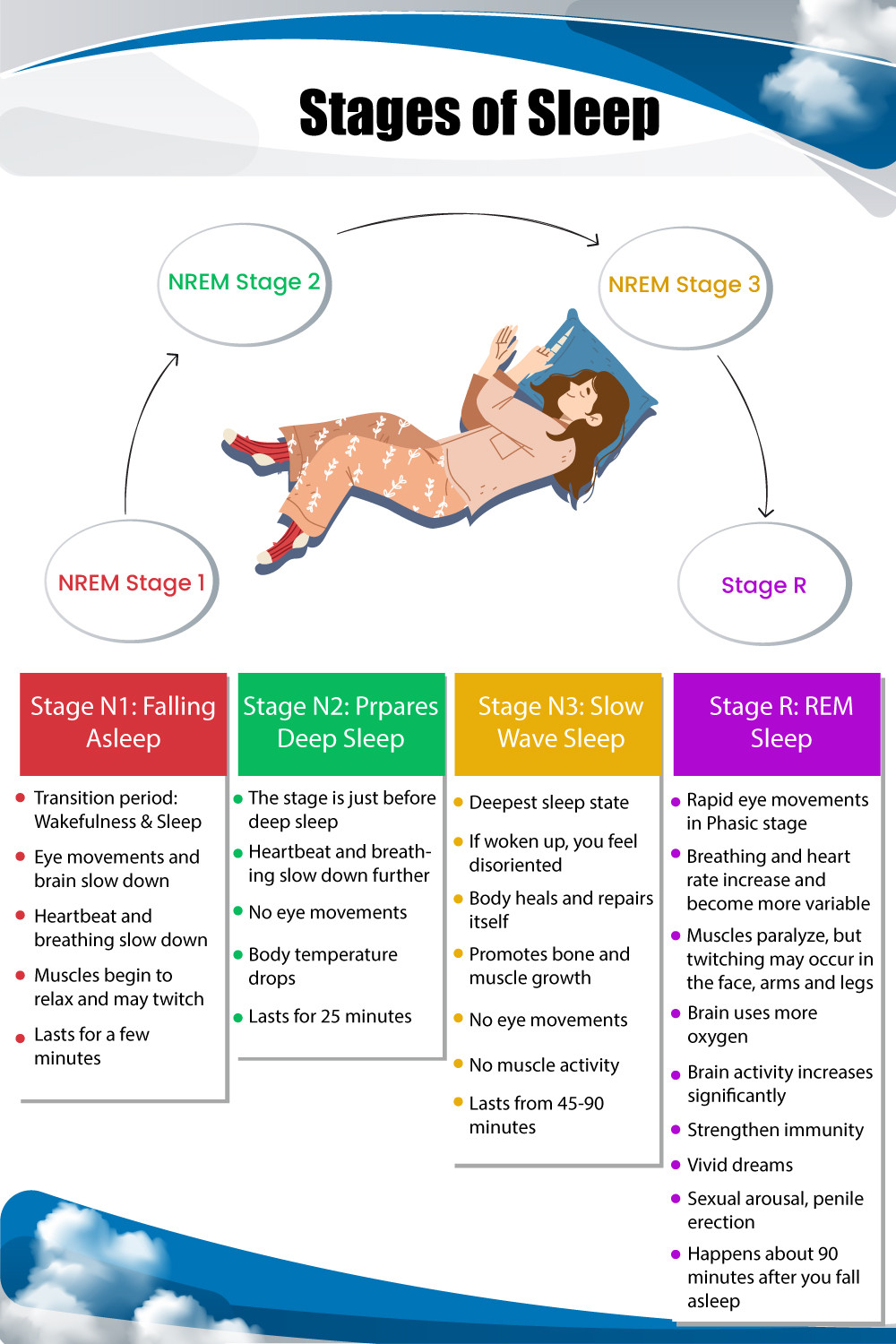How do you spring out of bed every morning? Are you fresh or dull? Do hours of sleep bring you any good? Why do you feel sleepy throughout the day despite sleeping through the night? Why don’t some of us sleep as soon as the body lies at rest on our comfy beds?

To answer such questions, we need to understand how your brain cycles run through the four stages of sleep.
Stages of sleep
Each stage has a particular function in maintaining the brain’s cognition. The entire sleep cycle repeats several times in one night.
What is Non REM sleep?
Non-REM means when there is No Rapid Eye Movement. Most adults enter from the drowsy state into Non-REM (NREM) sleep. NREM heals physically, helps recover from illness, solves problems, improves working memory, brings verbal fluency, and facilitates motor learning and word memory. As you age, Non-REM sleep reduces.
If you awake from Stage 1 of Non-REM sleep, you might feel that you were not really sleeping. You may feel like you’re about to fall, and then a sudden muscle contraction or a Hypnic jerk happens, which is common and is not a complicated issue.
Stage 2 of Non-REM sleep involves the highest percentage of total sleep and is considered a lighter sleep stage from which you awake easily.
Stage 3 of Non-REM sleep is known as slow-wave sleep, deepest sleep, regenerative state, or delta sleep. Several significant health-promoting functions take place in this third stage of Non-REM sleep. You will not be easily woken up from this stage as your body works to repair tissues and bones and strengthen your immune system. Your brain consolidates declarative memories like general knowledge, facts and figures, personal experiences, and things you have learned.
What is REM sleep? What is its importance?

REM sleep meaning is associated with the movements of the eye. REM - Rapid Eye Movement. Our eyes dart rapidly beneath the eyelids, but don't send any visual signals to the brain. It starts after 90 minutes of sleep. It lasts for 10 minutes initially, but gradually, it increases to as long as an hour in the last sleep cycle before you awake. It is highest during infancy and early childhood but reduces during adolescence and young adulthood. It further reduces as you get older.
REM sleep significantly increases brain activity, promotes learning, makes or retains memories, directs mood and creates dreams.
The importance of this stage lies in the fact that your brain exercises vital neural connections that are key to mental and overall well-being and health.
The lack of REM sleep could increase weight, consolidate memory, and act out dreams.
Do you sleep adequately on time? Enroll in the Free Intro-talk on Wellness. Gain awareness in a 40-minute, free session by prestigious Doctors & Teachers.
Stage 4 or REM sleep consists of two phases Phasic and Tonic. Phasic involves rapid eye movements in comparison to Tonic. REM sleep starts about an hour and a half after you go to sleep. The first REM period lasts about 10 minutes. The following REM stage gets longer. The duration of REM sleep changes as you age.

When the sleep cycles get disrupted, problems like reduced learning and focusing, lesser creativity, confused decision-making, slow problem-solving, recalling memories or information and controlling emotions or behaviors might happen. They might have pain, inflammation, high blood pressure, heart disease, obesity, diabetes, and reduced quality of life.
But Sudarshan Kriya has shown a positive impact in improving the sleep quality of the practitioners.
Impact of Sudarshan Kriya, the powerful breathing technique on REM sleep quality
Sudarshan Kriya improved rapid eye movement (REM) latency and slow wave sleep.
Insomnia is one of the common symptoms of stress that responds to daily practice in the form of improved sleep quality.
Research shows the technique helps improve the sleep cycle, improves the secretion of happy or feel-good hormones like oxytocin, and reduces the secretion of stress hormones like cortisol. It leads to better sleep.
Slow wave sleep [non-REM (rapid eye movement) S3 and S4] had reduced in the middle-aged control group.
Enhance non-REM sleep low-frequency oscillations.
Research also indicates that prolonged Sudarshan Kriya practice improves parietal-occipital EEG gamma activity during sleep. This change in gamma activity is required for NREM sleep and indicates better quality.
The results show that immediately after the Online Meditation and Breath Workshop (where Sudarshan Kriya is the heart of the workshop), the percentage of the overall population with good quality of sleep (PSQI < 5) almost doubled, which is a substantial difference.
Yoga Nidra meditation for sleep and relaxation with Gurudev Sri Sri Ravi Shankar
Testimonial
Better Sleep
I used to have very disturbed sleep. It continued for almost two and a half years. I used to feel a lot of fear, anxiety and restlessness. After the first Sudarshan Kriya, I slept like a baby. I got the most refreshing 6 hours of sound sleep.
- Gunjan Arora, IT Professional, Bangalore
Inspired by Gurudev Sri Sri Ravi Shankar’s wisdom talks
Written by: Pratibha Sharma
Reference links
Sudarshan Kriya Yoga: Breathing for health
The influence of Sudarshan Kriya on sleep quality
Related links
Release your worries: meditation for sound sleep
7 ways to have a good night’s sleep
FAQs on REM sleep
The brain stem (pons and medulla) is responsible for REM sleep. It sends signals to relax muscles, which is essential for body posture and limb movements.
Usually, REM sleep happens 90 minutes after going to sleep. But only in narcolepsy do you suddenly go into REM sleep without NREM sleep, both at night and during the day.
































